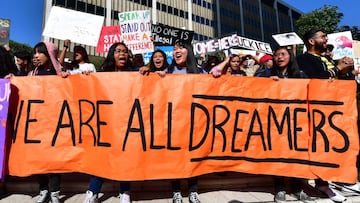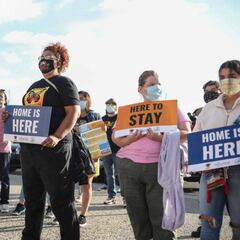What is DACA and how has it protected children?
GOP attacks on DACA, the immigration program to protect those who came to the US as kids, continue with a judge in Texas ruling that the program is unconstitutional.


Immigration reform has been talked about at the federal level for decades, yet Congress has done very little to fix the country’s broken system.
The Deferred Action for Childhood Arrivals or DACA as it is more commonly known, is an immigration policy that protects many who came to the United States illegally as children from deportation. Immigrants who came to the United States as children are called DREAMers. DREAMers are nurses, soldiers, teachers who contribute to society and, before DACA, lived under constant fear or separation. For many DREAMers, the United States is the only country they have ever known.
While DACA does not protect children, rather adults who migrated as children, the Center for American Progress found that the average DREAMer protected under DACA “arrived in the United States in 1999, at age 7,” with more than a third arriving before the age of five.
Today, the average age of a DACA recipient is 28, and in total, they and “their households pay $5.6 billion in federal taxes, and $3.1 billion in state and local taxes, each year.”
Recent efforts to end DACA
More recently, a Federal court in Texas ruled that the program was unconstitutional. President Biden described the court’s ruling as “disappointing,” a word he also used when speaking about the inability of Congress to create a legal path to citizenship for immigrants brought to the US as children.
Yesterday’s Federal court ruling is deeply disappointing. While the court’s order does not now affect current DACA recipients, this decision nonetheless relegates hundreds of thousands of young immigrants to an uncertain future. It is my fervent hope that Congress will act.
— President Biden (@POTUS) July 17, 2021
This judicial action will allow nine states -- Alabama, Arkansas, Kansas, Louisiana, Mississippi, Nebraska, South Carolina, Texas, and West Virginia -- to stop processing DACA applications but will not impact those who have already been approved.
In a statement relates by the White House on 17 July, the President stated that “only Congress can ensure a permanent solution by granting a path to citizenship for Dreamers." Biden called on lawmakers to pass a bill that provides "the certainty and stability that these young people need and deserve.”
When did DACA start?
President Obama used his executive authority to begin the program in July 2012. Through executive order, he allowed those eligible to be protected from deportation and given the right to work in the US for two years.
After the two years has ended, individuals were able to reapply. To receive the benefit, that applicant must undergo an extensive background check, which also must be completed each time the applicant renews their DACA status.
Through the Obama administration program, not all DREAMers were able to apply for protection. DACA only covered those who had no criminal record and
- Were sixteen or younger when they arrived;
- Were younger than thirty-one when President Obama signed the Executive Order; and
- Had lived in the United States since 2007.
Trump moves to end DACA.
In 2017, President Trump ended the DACA program.
At the time, U.S. Citizenship and Immigration Services published a report showing that were around 689,800 DACA recipients in the US, of which forty-five percent resided in California and Texas. Almost eighty percent had come to the United States as children from Mexico.
During the announcement, President Trump said that although he was not “favor punishing children, most of whom are now adults, for the actions of their parents,” but that that the country must remember “that we are a nation of opportunity because we are a nation of laws.”
Some believed that the president made the change to encourage Congress to pass comprehensive immigration reform; however, a bill never materialized.
DACA saved by the Supreme Court and President Biden
In 2020, the Supreme Court ruled that Trump violated Constitutional law by ending the program. In the 5-4 decision, Chief Justice John Roberts joined the four liberal justices to rule that the administration had not provided sufficient evidence to justify ending the program.
Former Pres. Barack Obama on DACA ruling: "It’s long past time for Congress to act and give them the protection and certainty they deserve." https://t.co/BJK9K08AI2 pic.twitter.com/wMBdMY0Dp7
— ABC News (@ABC) July 18, 2021
Even in Justice Kavanaugh’s dissent, he acknowledged that the uncertainty faced by DACA receipts stems from “Congress’s inability thus far to agree on legislation, which in turn has forced successive administrations to improvise, thereby triggering many rounds of relentless litigation with the prospect of more litigation to come."
In December 2020, a US District Judge ordered the Department of Homeland Security to begin accepting applications. Further bolstering the program, Biden signed a Presential Memorandum to reinstate the program on his first day in office.
Related stories
In his Executive Order, President Biden mandated that the Department of Homeland Security defer the removal of “certain undocumented immigrants who were brought to the United States as children, have obeyed the law, and stayed in school or enlisted in the military.”
However, without Congress, the fate of Dreamers and other immigrants remains in limbo. At the current moment, there are very few lawmakers making a public case for serious immigration reform.

